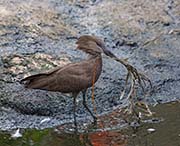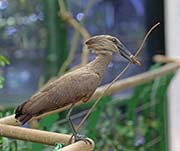Hamerkop - Scopus umbretta
| Length | |
| Wingspan | |
| Weight | |
| Clutch Size | |
| Chicks at birth | |
| IUCN Conservation Status | |
Continents: |
Hamerkop are known by a number of different names including: Hammerkop, Hammerhead, Hammerhead Stork, Umbrette, etc. They are found in sub-Saharan Africa, coastal Arabia and Madagascar.
Hamerkop are a plain dark brown with a large, long, flat and slightly hooked bill. Their crest gives them the hammerhead effect. Their legs are moderately long and the legs and feet are black. They have a short tail and the wings are big, wide and round-tipped and suitable for soaring. Their irises are brown. Both sexes are similar. Chicks are covered with pale gray down and legs are pinkish at first and then later turn brown.
Diet: Hamerkops tend to feed singly or in pairs. They mainly eat amphibians but also eat fish, shrimp, insects and rodents.
Courtship: Hamerkops appear to breed year-round in east Africa and breed primarily during the dry season in other locations. What may be their courtship display includes 10 or fewer birds running circles around each other, calling, raising their crests and fluttering their wings. Also, one bird may stand on another as if they were going to mate but do not actually mate. Actual mating between pair occurs during nest-building and after nest is complete. They are considered monogamous.
Nesting: Hamerkops build one of the largest known nests (5 feet across). The nest is a domed structure with a narrow, round entrance hole. The entrance tunnel to the interior of the nest is plastered with mud. The nest is big enough for the adult and the young to be in.
Nests can be situated on a cliff ledge, a tree fork, a dam or the ground. The structure is mostly constructed from twigs and sticks but nests can be decorated with all kinds of items including bones and human garbage. Hamerkops will build 3-5 nests per year whether they use them or not. Other animals may use these nests or attach their nests to the outside (e.g., weaver birds, mynas, etc.)
The female lays 3-7 white eggs in the central chamber. Both sexes incubate the eggs and both will feed the young.
Habitat and Range: Hamerkop are found in sub-Saharan, Madagascar and parts of coastal southwest Arabia in wetland habitats including irrigated land (e.g., rice paddies, dams or canals), estuaries, lakesides, ponds, riverbanks, etc.
Vocalization: Hamerkop are usually silent when solitary, vocal in groups, loud, somewhat nasal yelping and trumpeting of varying tempo.
Plumage/Molt Hamerkops have an annual complete molt.
Migration: Mostly sedentary but may do some local movement.
Tongue/feet: Hamerkop feet are partially webbed. Since they are not swimmers, the reason is not known.
Bibliography:
- Maclean, Gordon Linday, Robert's Birds of Southern Africa,John Voelcker Bird Book Fund, 1985
- http://en.wikipedia.org The Free Encyclopedia, Accessed April, 2012
- http://marylandzoo.org Maryland Zoo, Accessed April, 2012
- http://birdsofseabrookisland.org Birds of the World, Accessed April, 2012








